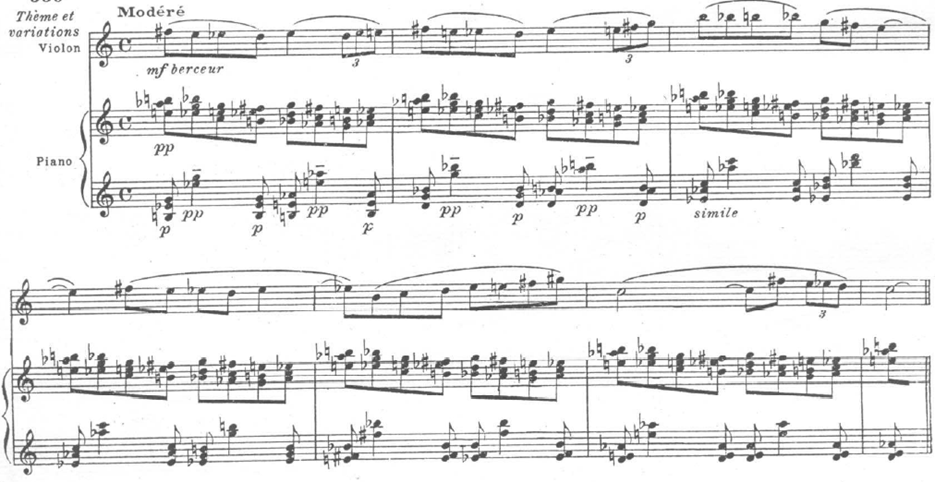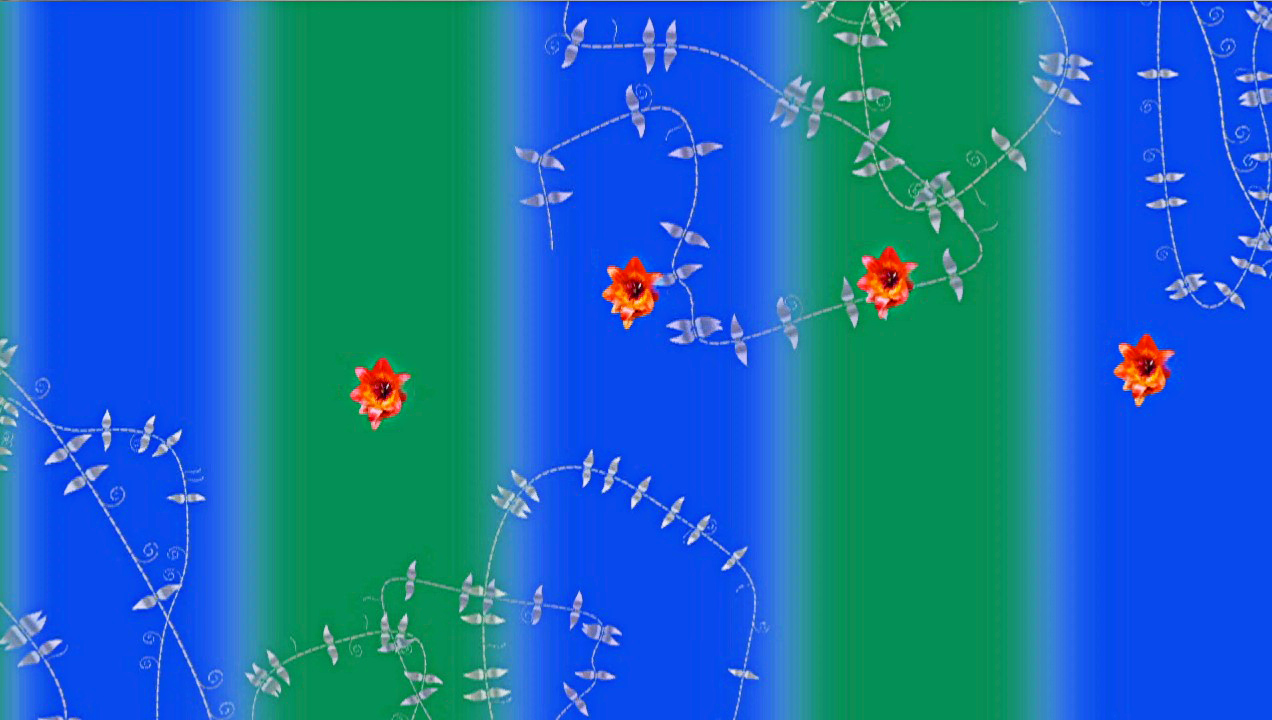COLOUR CORRESPONDENCE FOR MODE 6 ACCORDING TO OLIVIER MESSIAEN
Mode 61
General colour:
Large gold letters on a grey background, with orange spots, and rather dark green branches with golden reflections
Mode 62
General colour:
Leather and chocolate colour, with reddish orange and dark purple areas- some lightened pale grey and purple
Mode 63
General colour:
Transparent sulfur yellow, with purple reflections, with prussian blue and purplish brown corners
Mode 64
General colour:
Yellow, purple and black vertical stripes
Mode 65
General colour:
Gold, pale blue, purple, with brown designs
Mode 66
General colour:
White and black vertical stripes, dotted with pale blue moons
The cluster of chords that keeps repeating in the upper staff of the piano constitutes a pedal group: “instead of one sustained note, foreign to the chords which surround it, we shall have a repeated music (repetition and sustaining are equivalent) foreign to another music situated above or below it; each of these musics have its own rhythm, melody, harmonies".⁂
In his “Technique of my Musical Language” Messiaen specifically mentions this excerpt from Theme et Variations where Mode 3 is being used (and not just in its first transposition).
MODE 3
We will now analyze Mode 3 in the same way.
Mode 3 is transposable 3 times (as opposed to Mode 2, that is transposable only 2 times) just as the augmented 5thchord. It is divided into three symmetrical groups of four notes each. These “tetrachords” taken in ascending movement, are divided themselves into three intervals, one tone and semitones. Here are the 3 transpositions of Mode 3, and the chord succession realized with each voice starting from a different degree:
MODE 6-MODE 7
Since we will not be needing modes 1,4,5 for the analysis of Messiaen's Thème et variations we will now continue with Mode 6.
Both Mode 6 and Mode 7 are transposable 5 times. It is interesting that Messiaen doesn't provide a colour correspondence for Mode 7. Scholars are comimg up with different explanations with regards to why this is the case for Mode 7. "Mode 7 has too many notes to evoke vivid colors; or perhaps it has an effect to him of "stained-glass" window chords, in which all hues of the rainbow are present at once, in sharp delineation from one another."⁂
MODE 2
We shall start with Mode 2 as it is of more importance for the piece we will be analyzing shortly: Messiaen’s Theme et Variations. Mode 2 is 3 times transposable just like the diminished 7th chord.
In a more condensed form, we can write the parallel succession of chords (with each voice starting from a different note of the mode). This gives us “super positioned” 4ths and 6ths with an added augmented 4th, alternated with dominant seventh chords with an added sixth. (See the 4th image in the slideshow)->
COLOUR CORRESPONDENCE FOR MODE 3 ACCORDING TO OLIVIER MESSIAEN
Mode 31
General colour:
Orange tablecloth, with gold and milky white designs, and some ash grey spots (these spots include purple or red, or green)
Dominant colour : orange, gold and milky white
Mode 32
General colour:
Horizontal stripes tied: from bottom to top: dark grey, purple, light grey, and white with purple and pale yellow reflections- with flamboyant gold letters, unknown writing, and a quantity of small red or blue arches, very thin, barely visible
Dominant colour: grey and purple
Mode 33
General colour:
Wide vertical stripes, alternatively cobalt blue and dark blue-green. On this background, scattered orange red saffron lillies, and some silver vines.
Dominant colour: blue and green
Mode 34
General colour:
Wide orange tablecloth, strongly stripped with red, finely stripped with blue. Blue, purple, silvery branches- white lilies, tiger lilies with red cinabre flowers punctuates with black-orange and blue fruits, orange and green fruits
Dominant colour: orange, red, with a little blue
The reason why this mode can be transposed only 2 times is because if we tried to start our patterned scale from E flat, we would get the first transposition again (the same pitches consisting of the 1st transposition). (See the 3rd image in the slideshow) ->
COLOUR CORRESPONDENCE FOR MODE 2 ACCORDING TO OLIVIER MESSIAEN⁂
Mode 21
General colour:
Violet blue rocks, dotted with small grey cubes, cobalt blue, dark Prussian blue, with some violet purple reflections, gold, ruby red, and purple stars, black, white.
Dominant colour: violet blue
Mode 22
General colour:
gold and silver spirals, against a background of brown and ruby red vertical stripes.
Dominant colour: gold and brown
Mode 23
General colour:
light and meadow green foliage, with blue, silver and reddish orange spots
Dominant colour: green
As discussed earlier Messiaen had a specific type of synaesthesia: chromaesthesia.
From a rather young age, Messiaen designed his compositional tools: the so called modes of limited transposition. A mode is just a scale: a way of arranging, some or all semitones of an equally tempered octave. Messiaen came up with seven modes using minor/major 2nds and minor/major 3rds to construct them.
As we know, any normal major or minor scale, can be transposed up to twelve times to produce twelve unique scales. However, Messiaen's modes don't have twelve transpositions: after a finite number of chromatic shifts (that is not the same for every mode) the original notes are reproduced.
In his Technique of Musical Language- and Traité Messiaen gives musical examples that use this 2nd Mode by Rimsky-Korsakov (1844-1908) and Claude Debussy (1862-1918). In fact, according to Messiaen, the history of Mode 2 could be confused with that of the Neapolitan sixth. Mode 2 consists primarily of this sequence:

















